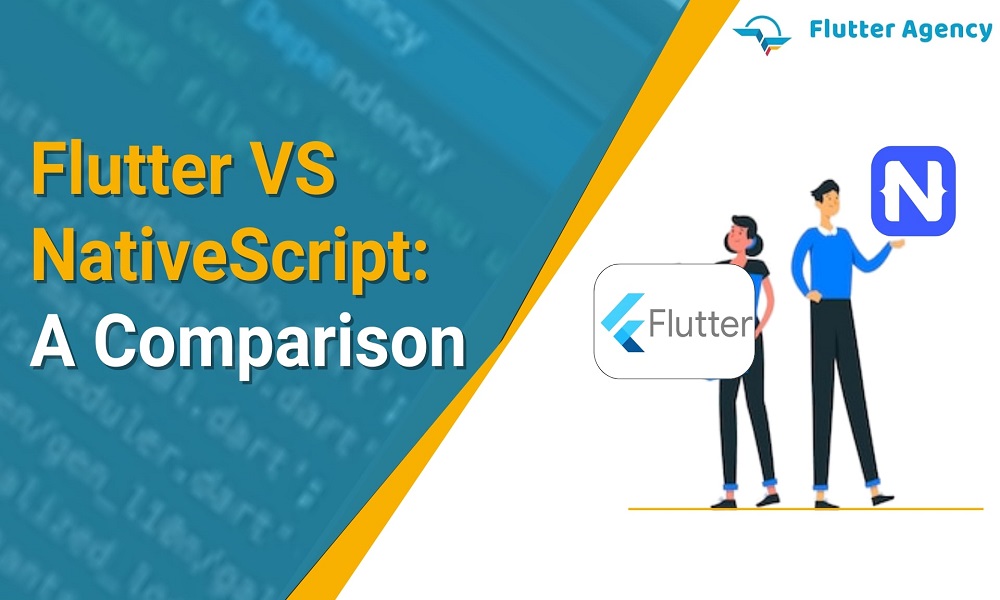Flutter Vs. NativeScript Comparison For Tech Industry and Entrepreneurs
Nowadays, many businesses across the globe are relying on cross-platform app development more than before. Hence, the usage of cross-platform development frameworks has reached its peak.
Furthermore, these frameworks help to develop high-quality apps faster. It makes it easy to code, improves performance and will increase the number of users for your app. It also allows you to save money by deducting the number of hours you require to spend on your app.
Additionally, you get the ability to customize it as per your needs. It leads to an increase in the number of app downloads. However, companies are generating more revenue and have increased their brand visibility.
It seems to be challenging to hire the correct developers for your business. It also creates confusion between Flutter Vs. NativeScript for the development. So, we have written this article to differentiate both these frameworks in detail.
Overview: Flutter Vs. NativeScript
Flutter
Flutter is an open-source framework released in 2018 by Google for developers to create high-quality performing apps in various operating systems, which includes iOS and Android. It makes use of the Dart language for programming. Flutter facilitates you to create modern, performant apps by reusing the code. So, instead of plumbing, you can focus on the coming.
An emerging Flutter framework supports the various technologies from the web to native, allowing you to create an app the users want. Moreover, Google’s brainchild made constructing complicated and high-quality apps easy without worrying about a platform.
Usually, Flutter utilized the strengths of native code to give a better app-building experience than existing cross-platform frameworks and languages like NativeScript. With every Flutter, Google favours Flutter to fight with all cross-platform frameworks in the market by extending a boundary for the programmers. Get to Know what is new and latest in Flutter 3.3.
NativeScript
NativeScript is another open-source, cross-platform framework that enables the development of genuinely native mobile apps with JavaScript from 2014. On the contrary, other frameworks use Cordova rendering, but NativeScript has a rendering engine that renders a native-like user experience and performance.
In addition, it provides direct access to every native platform API by using TypeScript, Angular or JavaScript. Therefore, the developers can benefit from web development skills to build a native mobile app. Also, it offers a wide range of templates and plugins, which will smoothen the app development process.
NativeScript offers functionality such as the integration of Angular and Vue.js, native-like performance, XML for platform-independent UIs, and code reusability, which make it popular and well-known among businesses and developers.
Comparison Between Flutter Vs. NativeScript
Let us see some differentiation between Flutter vs NativeScript.
| Flutter | NativeScript |
| 1. It is the open-source framework, cross-platform SDK, and UI toolkit from Google | 1. It is also the open-source framework for front-end, cross-platform development from the progress |
| 2. It has come with pre-configured widgets, like buttons, tabs and layouts, which will work as the building tools | 2. It has come with the pre-configured components used to develop a user interface |
| 3. Make the use of Dart programming language to build the Flutter app | 3. Use JavaScript or any other programming language like Typescript |
| 4. It supports the Android Studio, Visual Studio code and Xcode | 4. It supports different IDEs like Intellij, VScode, and Xcode |
| 5. The primary concept of Flutter architecture in layers | 5. It uses the MVC or MVVM architectural patterns |
| 6. It supports automated testing and takes the minimal time | 6. NativeScript provides default testing with the workflow of QA and takes the more time |
| 7. It has about 3200+ libraries with the command line interface | 7. It has about 1200 libraries with the command line interface |
| 8. Google ads and eBay are examples of Flutter | 8. Roni multiplayer game, Ntice_Me-dating app, are some examples of NativeScript |
We have only compared some essential aspects of Flutter vs NativeScript. But, after reading the article below, you will know whether to choose Flutter developers or a NativeScript developer for your next project.
Performance comparison of Flutter Vs. NativeScript
The performance characteristics of Flutter and NativeScript are superficial when you compare both platforms side-by-side. NativeScript is faster, but the Flutter app development is preferred more for mobile apps. The other benefit is that it uses the resources of a host device. In other words, it also works on the hardware and is optimized to use system resources as is possible on the platform.
Flutter uses the hardware-accelerated Skia 2D graphics engine for rendering. Besides that, its goal is to offer 60 to 120 frames per second performance on gadgets that have a capacity of 120Hz updates.
NativeScript apps have an impressive performance and maintain about 60 FPS without any issues. It takes time in front-end development but provides better performance and speed. Lastly, combining the manual and instrumental tools can help optimize and improve performance.
The architecture of Flutter Vs. NativeScript
Flutter uses layered architecture, whereas a NativeScript follows the MVC or MVVM architectural pattern.
The highest level of the root functions or the platform-specific widgets comes first in the hierarchy of apps developed with Flutter and then comes basic widgets. Hence, Flutter is a practical choice for building small to large-scale applications. It becomes possible with the architecture, which permits you to use simple or complicated components as required.
NativeScript, like other frameworks, is created on several modules, each with its functionality. It has several plugins and customization features as this framework is MVC friendly which authorizes you to manage the modules well, which in turn helps the enterprise applications with some particular and unique features.
What can you create with the Flutter Framework?
- Minimum viable product – MVP
- Interactive apps with a material design
- A single codebase runs the apps on Android, Web, Windows, Desktop and Android platforms
- Applications are compatible with the platform-specific feature
- High-performing and fast apps with the Skia rendering engine
- Flexible UI with customizable widgets
What can you create with NativeScript?
- An app is compatible with massive server connectivity
- Web technologies use Native apps
- Cross-platform mobile apps for iOS and Android
- Enterprise-grade apps
Advantages and disadvantages of Flutter
Advantages
- Excellent consistency of user interface and business logic on multiple platforms
- It can simplify complex mobile UI design with customizable widgets
- Skip engine delivers high performance
- Make development of the app faster with a hot reload functionality
- Automates the testing support
- Faster time-to-market
Disadvantages
- Limited third-party plugins and libraries
- Lack of 3D capabilities
- Huge file size
What are the advantages and disadvantages of NativeScript?
Pros
- It is easy to style native apps by using an abstraction of CSS
- Extensive frameworks and the plugin support
- Develop cross-platform mobile apps by the use of web development skills
Cons
- All UI components are not free to use
- It isn’t easy to share code with the web build
- It takes much time to test the apps
- Low response time to the new features of Android
Conclusion
Flutter and NativeScript are both frameworks that help you build cross-platform mobile applications. It has been clear how Flutter has gained popularity due to its performance, functionality, and single code base. On the other hand, engineers who know about JavaScript and its framework can go for NativeScript to get a start with native app development.
We recommend you consult the tech geeks who help you select the best. However, it is vital to analyze your requirement from the technical point of view to choose the right stack.
Frequently Asked Questions (FAQs)
1. Is Flutter faster than NativeScript?
Yeah!Of Course. In terms of the development speed, deployment and debugging, Flutter is quick. It didn’t need any bridge for communicating with the native modules as it is a native component by nature.
2. What is the difference between Flutter and Native?
From the speed of development to deployment, there is a significant difference between the NativeScript and Flutter. The performance of the same apps created in both frameworks also varies.
3. Is NativeScript helpful in creating complex applications?
Complex and advanced apps will work flexibly with the NativeScript framework. Hence, setting up the environment on this platform is much easier.
Contemporary ventures
Recent blog
ready to get started?
Fill out the form below and we will be in touch soon!
"*" indicates required fields









